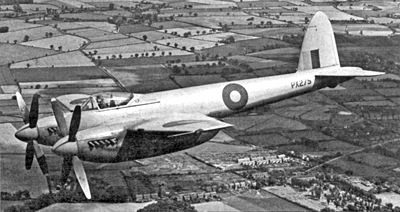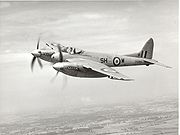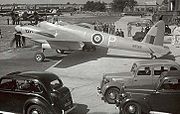de Havilland Hornet Airplane Video - R.A.F. British Fighter
More De Havilland Hornet Videos 1 - De Havilland Hornet Pictures
|
|
|
|
 |
Crew: 1 Length: 36 ft 8 in (11.18 m) Wingspan: 45 ft (13.72 m) Height: 14 ft 2 in (4.3 m) Maximum speed: 472 mph at 22,000 ft (760 km/h) Range: 3,000 mi (4,828 km) Rate of climb: 4,000 ft/min (20.3 m/s) |
Role: Land- and naval-based fighter aircraft
First flight: 28 July 1944
Introduced: 1946
Retired: 1956
Primary users: Royal Air Force, Royal Navy
Produced: 1945 to 1950
Number built: 383
The British de Havilland DH.103 Hornet was a piston engine fighter that further exploited the wooden construction techniques pioneered by de Havilland's classic Mosquito. Entering service at the end of the Second World War, the Hornet postwar equipped Fighter Command day fighter units in the UK and later was used with success as a strike fighter in Malaya. The Sea Hornet was a carrier-capable version.
Design and development
 (Image: Hornet F 3, c. 1948)
(Image: Hornet F 3, c. 1948)
Designed as a private venture for a long-range fighter for use in the Pacific Theater in the war against Japan, the Specification F.12/43 was written around the type. From an early stage it was also envisaged that the Hornet could be adapted for naval use, operating from carriers. As a result priority was given to ease of control, especially at low speeds, and good pilot visibility. Construction was of mixed balsa/ply similar to the earlier de Havilland Mosquito, but the Hornet differed in incorporating stressed Alclad lower-wing skins bonded to the wooden upper wing structure using the then-new adhesive Redux. The two wing spars were redesigned to withstand a higher safety factor of 10 versus 8.
Apart from the revised structure the Hornet wings were a synthesis of aerodynamic knowledge that had been gathered since the Mosquito's design process, being much thinner in cross section, with de Havilland designers adopting a laminar flow profile similar to the P-51 Mustang and Hawker Tempest. Control surfaces consisted of hydraulically operated split flaps extending from the wing root to outboard of the engine nacelles; like the Mosquito the rear of the nacelles were part of the flap structure. Outboard, the Alclad-covered ailerons extended close to the clipped wing tips and provided excellent roll control.
 (Image: RR915 Hornet prototype)
(Image: RR915 Hornet prototype)
The Hornet used "slimline" Rolls-Royce Merlin engines that were versions of the Merlin with engine ancillaries repositioned to achieve minimum frontal area and drag. The aircraft was somewhat unusual in a British design in that it had propellers that rotated in opposite directions. To achieve this the engines used slightly different gearboxes, hence the double Merlin marks of 130/131. This feature effectively cancels the variable and cumulative torque effect of two propellers turning in the same direction that had affected earlier designs such as the Mosquito, in turn reducing the amount of adverse yaw caused by aileron trim corrections and generally providing more stable and predictable behaviour in flight. Initially the propellers were "handed" to rotate inboard, towards the fuselage, but this was found to reduce the effectiveness of the rudder so propellers "rising" outboard were used instead.
Because of the revised induction arrangements of the Merlin 130 series, the supercharger and carburettor air intakes could be placed in the leading edges of the wings, outboard of the nacelles. Other versions of the Merlin, which used "updraft" induction arrangements required that the intakes be placed in a duct below the main engine cowling. The main radiators were also mounted in the inboard leading edges of the wings. Internal fuel, to a maximum capacity of 432 Imp gallons (1,964 l) (F 3) was provided in four self-sealing wing tanks which were accessed through detachable panels forming part of the lower wing surfaces.
To assist airflow over the wing the engine nacelles were mounted low, which meant that the undercarriage legs were reasonably short and the pilot's field of view was improved.
The single legged undercarriage units were simpler and cleaner than those of the Mosquito, using the same de Havilland-developed rubber-in-compression energy absorption system. The mainwheels were also smaller and lighter.
To further aid the pilot's field of view the unpressurised cockpit was mounted well forward in the fuselage and was housed under an aft sliding, perspex blister canopy. The three-panel windscreen was designed so that refraction through the panels meant that there were no obvious blind spots caused by the corner tie-rods; all three panels were bullet-proof laminated glass. An armour plate bulkhead (hinged near the top to provide access to the back of the instrument panel and the rudder pedals), was part of the nose structure, with the pilot's back and head being protected by another armour plate bulkhead built into the cockpit. Below and behind the cockpit floor was a bay housing the built-in armament of four short-barrel 20mm Hispano V cannon, with 190 rounds per gun, firing through short blast tubes.
Fuselage construction was identical to the earlier Mosquito; a balsa wood "pith" sandwiched between plywood sheets which were laid in diagonal panels. Formaldehyde cement was the bonding agent.
The fuselage halves were built on large concrete or wood patterns, equipment was fitted in each half and they were then joined along the top and bottom centre lines using wooden reinforcing strips. The entire fuselage was then tightly wrapped in fine aviation fabric which was doped in place. The tailfin which had the trademark, gracefully curved de Havilland shape, was an integral part of the rear fuselage. On Late Mk Is and future production aircraft, a fin fillet was added to the base of the unit.
The horizontal tail unit was an all-metal structure, again featuring the distinctive de Havilland shape.
Hornet F-3
The Hornet F 3's wings were stressed to carry external ordnance. Two to four "60 lb" (27 kg) RP-3 rockets could be carried under each wing; it was also possible to carry a combination of four rockets with one bomb of up to 1,000 lb (453 kg), or an additional drop tank on each wing, ranging in capacity up to 200 Imp gallons (909 l). Internally the fuel tanks were enlarged from a total capacity of 360 Imp gallons (1,636 l) to 432 Imp gallons (1,964 l) and additional equipment was added. Larger horizontal tail surfaces were adopted, with larger elevator horn balances. With the evolution of longer-range, jet-powered fighters such as the later de Havilland Vampire marks and the de Havilland Venom and Gloster Meteor, the Hornet became obsolescent fairly quickly. The F 3 was the last Hornet derivative to see operational RAF service.
Hornet PR 2 and FR 4
The Hornet PR 2 was intended to operate as a long-range Photo Reconnaissance aircraft. The Hispano cannon were removed and cameras were mounted in the rear fuselage. Total internal fuel capacity was increased to 528 gallons (2,400 l).PX216, PX220 and PX249 converted from standard Mk Is were the prototypes, followed by five more. The requirement for these aircraft lapsed with the end of the Second World War in the Pacific; all were used in arrestor barrier trials at Boscombe Down, and scrapped before entering RAF service.
Twelve Hornet FR 4s were modified from F 3s in much the same way, except that the cannon were retained and the internal fuel capacity slightly reduced from that of the fighter. These FR 4 derivatives saw service with the RAF in Malaya and Hong Kong in the early 50's.
Sea Hornet F 20, NF 21 and PR 22
 (Image: de Havilland Sea Hornet F Mk 20s of No 728 Fleet Requirements Unit, Hal Far, Malta.)
(Image: de Havilland Sea Hornet F Mk 20s of No 728 Fleet Requirements Unit, Hal Far, Malta.)
The Hornet was designed with the possibilities for naval service off carriers firmly in mind. To this end good low speed handling was required, along with good all round visibility for the pilot; the basic Hornet design excelled at meeting these requirements.
Shortly after the first Hornet prototype flew Specification N.5/44 was issued to de Havilland covering the modification of the Hornet for naval service. Heston Aircraft Co. was contracted to carry out the conversion work on three early production F.Is. The work entailed altering the wings to incorporate folding mechanisms so that each outer wing panel, from the aileron/flap line outboard could be folded upwards and inwards at an angle. The hinges were part of the upper wing skin structure while the lower wing skins incorporated securing latches. Lockheed hydraulic jacks were used to actuate the wing panels. Slotted flaps were introduced to improve low speed "flaps down" control.
The lower rear fuselage was reinforced with two additional spruce longerons designed to take the stresses imposed by the external "vee" framed arrestor hook, which was flush-mounted below the fuselage. The frame was made up of steel tubing with a forged-steel hook and was held against the fuselage by a "snap gear". Because the Hornet used the American "3-point" system of catapult assisted take off two forged steel catapult bridle hooks were fitted, one below each wing, and close to the fuselage.
The de Havilland rubber-in-compression undercarriage legs could not absorb the rebound energies imposed by carrier landings; these were replaced by more conventional hydraulic oleos which embodied torque links. Merlin 133/134s (derated from 2,070 hp (1,543 kW) to 2,030 hp (1,535 kW)) were fitted to all Sea Hornets.
Other specialised naval equipment (mainly different radio gear) was fitted and provision was made for three camera ports, one on each side of the rear fuselage and one pointing down. Sea Hornet F 20s also incorporated the modifications of the Hornet F 3, although the internal fuel capacity was 347 Imp gal (1,557 l), slightly reduced from that of the F I. In total all of the modifications added some 550 lb (249 kg) to the weight of the aircraft. Maximum speed was decreased by 11 mph (18 km/h).
The Hornet NF 21 was designed to fill a need for a naval night fighter. Special flame dampening exhausts were installed, and a second basic cockpit was added to the rear fuselage, just above the wing trailing edges. ASH radar equipment was placed to the rear of this cockpit, with the radar operator/navigator seated facing aft. To gain access a small trap door was provided in the lower fuselage; a fixed, teardrop shaped bubble canopy, which could be jettisoned in an emergency, provided a good field of view. At the front of the aircraft the nose underwent a transformation with the small rotating ASH radar dish being housed under an elongated "thimble" radome. The horizontal tail units were increased in span. The effect of these modifications on performance was minimal; about 4 mph (6 km/h)
The Sea Hornet PR 22 was a dedicated photo reconnaissance aircraft version of the F.20. The cannon were removed and the apertures faired over. Three cameras were installed in the rear fuselage; two were F.52s for diurnal use and one K.19B for nocturnal. A total of 23 of these were built, interspersed with F.20s being built at Hatfield.
The lone civilian Hornet was a Sea Hornet F.20 TT193. It had been sent to Edmonton, Alberta, Canada for winter trials and was later sold rather than be transported back to England. Registered CF-GUO, it was operated by Spartan Air Services and Field Aviation until June 11, 1952 when an engine failure caused a forced landing at Terrace, British Columbia. Some of the remains are still there in private hands.
Flying the Sea Hornet
Captain Eric "Winkle" Brown, former fighter pilot and officer of the Fleet Air Arm, is one of the world's most accomplished test pilots and he still holds the record for flying the greatest number of different aircraft types.
Just after VE Day the first semi-navalised Sea Hornet PX212 arrived at the RAE, Farnborough. Eric Brown initiated "work-up-to deck landing" trials; 37 years later he was still impressed:
"...the next two months of handling and deck landing assessment trials were to be absolute joy; from the outset the Sea Hornet was a winner!"
"The view from the cockpit, positioned right forward in the nose beneath a one-piece aft-sliding canopy was truly magnificent. The Sea Hornet was easy to taxi, with powerful brakes... the takeoff using 25 lb (2,053mm Hg, 51"Hg) boost and flaps at one-third extension was remarkable! The 2,070 hp (1,540 kW) Merlin 130/131 engines fitted to the prototypes were to be derated to 18 lb (1,691 Hg, 37"Hg) boost and 2,030 hp (1,510 kW) as Merlin 133/134s in production Sea Hornets, but takeoff performance was to remain fantastic. Climb with 18 lb (8.2 kg) boost exceeded 4,000 ft/min (20.32 m/sec)"...
"In level flight the Sea Hornet's stability about all axes was just satisfactory, characteristic, of course, of a good day interceptor fighter. Its stalling characteristics were innocuous, with a fair amount of elevator buffeting and aileron twitching preceding the actual stall"...
"For aerobatics the Sea Hornet was absolute bliss. The excess of power was such that manoeuvres in the vertical plane can only be described as rocket like. Even with one propeller feathered the Hornet could loop with the best single-engine fighter, and its aerodynamic cleanliness was such that I delighted in its demonstration by diving with both engines at full bore and feathering both propellers before pulling up into a loop!
During this series of tests Captain Brown found that the ailerons were too heavy and ineffectual for deck landing and there were some problems with throttle movement, brakes and the rubber-in-compression undercarriage legs still fitted. De Havilland were quick to modify the aircraft. Eric Brown:
"The landings aboard Ocean had been made without any crash barrier... Yet, in the case of the Sea Hornet, I had felt such absolute confidence that I was mentally relaxed... Indeed, there was something about the Sea Hornet that made me feel that I had total mastery of it; I revelled in its sleek form and the immense surge of power always to hand..."
"Circumstances had conspired against the Sea Hornet in obtaining the recognition that it justly deserved as a truly outstanding warplane...in my book the Sea Hornet ranks second to none for harmony of control, performance characteristics and, perhaps most important, in inspiring confidence in its pilot. For sheer exhilarating flying enjoyment, no aircraft has ever made a deeper impression on me than did this outstanding filly from the de Havilland stable."
Operational history
Hornet
The Hornet prototype RR915 first flew on 28 July 1944 with Geoffrey de Havilland Jr. at the controls. Powered by twin Merlin engines, it was the fastest piston-engined fighter in Royal Air Force service. The Hornet also has the distinction of being the fastest wooden aircraft ever built and the second fastest operational twin propeller-driven aircraft — being slightly slower than the unconventional German Dornier Do 335 of 1945.
The prototype achieved 485 mph (780 km/h) in level flight, which came down to 472 mph (760 km/h) in production aircraft.
The Hornet entered service in 1946 with 64 Squadron based at RAF Horsham St Faith. Next to convert to the Hornet was 19 Squadron at RAF Wittering, followed by 41 Squadron and 65 Squadron, both based at RAF Church Fenton. No. 65 Sqn was to participate in one of the first official overseas visits by an RAF unit when they visited Sweden in May 1948. Pilot conversion to the Hornet was provided by No. 226 Operational Conversion Unit (O.C.U.) which was based at RAF Molesworth.
During their relatively short operational service Hornets participated in several record attempts and air races; for example, on 15 September 1949 Flight Lieutenant H. Peebles flew from RAF Bovingdon to Gibraltar at an average speed of 357.565 mph (574.445 km/h), setting a new British point-to-point record, only to see it broken three days later when Group Captain A.P.C. Carver flew back to Bovingdon, averaging 435.871 mph (701.466 km/h).
Operationally the Hornet F I (later F 1) was to last only a short time before being superseded by the F 3 version. The first Hornet F 3 was PX366 which flew at the Farnborough Show in June 1946.
New units to convert to this mark were 33 Squadron, 45 Squadron (based at RAF Tengah, Singapore where, in early 1952, the unit converted to the Hornet from the unreliable Bristol Brigand) and 80 Squadron. Along with 64 Sqn these squadrons operated in Malaysia where they replaced Beaufighters and Spitfires operating against Communist guerrillas during the Malayan Emergency. Armed with rockets and/or 1,000 lb (454 kg) bombs Hornets, with their long range and good endurance, were able to spend up to two hours loitering over the target area. They also proved to be very reliable; 45 Sqn Hornets, based in Singapore achieved 4,500 operational sorties over five years. The last operational Hornet sortie was flown on 21 May 1955.
In 23 July 1954, two Hornets from RAF Kai Tak in Hong Kong were the first to arrive on the scene of a shotdown Cathay Pacific Skymaster off the coast of Hainan Island.
All Hornets were withdrawn from operational service by mid-1956. No complete examples of the Hornet remain in existence today, although a Hornet F.1 forward fuselage has now been reconstructed in the UK from the scant remains collected together over a number of years.
Sea Hornet
The Sea Hornet F 20 prototype, PX212, which didn't have the wing-fold mechanism, first flew on 19 April 1945. PX212 was later converted to the prototype NF Mk 21, first flying in this form on 9 July 1946.
The only unit fully equipped with Sea Hornet F.20s was 801 Squadron on 1 June 1947 at RNAS Ford. After a move to Arbroath they were embarked on HMS Implacable. In 1951 another move was made to HMS Indomitable until, in June, the Sea Hornets were replaced by Hawker Sea Furies.
Other Sea Hornets were attached to various Naval Squadrons, including three which were attached to 806 Squadron which, along with a Vampire and two Sea Furies was embarked on HMCS Magnificent for a tour of North America in 1948. The Sea Hornets gave several spectacular flying displays at the International Air Exposition in New York between 31 July and 8 August.
In January 1949 The Sea Hornet NF 21 equipped 809 Squadron at RNAS Culdrose: moves were made to HMS Illustrious and then, in May 1951 HMS Vengeance. The unit was then briefly seconded to the RAF at Coltishall before a posting to Hal Far Malta where it disbanded in 1954.
One Sea Hornet F 20, TT213, was acquired by the RAAF from the Ministry of Supply in the United Kingdom. The aircraft was used by the Aircraft Research and Development Unit (ARDU), at Laverton, Victoria, Australia from 1948 to 1950. It was mainly used for evaluation and tropical trials.
As with its land-based cousin, no examples of the Sea Hornet remain extant.
Variants
Hornet F 1
Fighter version, 60 built.
Hornet PR 2
Photo-reconnaissance version, 5 built.
Hornet F 3
Fighter version, 132 built.
Hornet FR 4
Fighter-reconnaissance version, 12 built.
Sea Hornet F 20
A navalised version for service on British aircraft carriers, 79 built.
Sea Hornet NF 21
Fleet Air Arm night fighter powered by Merlin 133/134 engines, 72 built.
Sea Hornet PR 22
Photo-reconnaissance version, 23 built.
Operators
Australia
Royal Australian Air Force - One aircraft used for evaluation and tropical trials.
Canada
Royal Canadian Air Force - One ex-Royal Navy Sea Hornet was operated briefly by the RCAF in 1948 for test purposes. It was operated by CEPE Canadian Experimental and Proving Establishment, at RCAF Namao, Edmonton, Alberta, in company with a Hawker Sea Fury. When surplused, it was purchased by Spartan Air Services and operated until one of the engines failed. It was the scrapped sometime in the fifties.
United Kingdom
Royal Air Force, Fleet Air Arm
Specifications (Hornet F.3)
General characteristics
Crew: 1
Length: 36 ft 8 in (11.18 m)
Wingspan: 45 ft (13.72 m)
Height: 14 ft 2 in (4.3 m)
Wing area: 361 ft² (33.54 m²)
Loaded weight: 19,550 lb (8,886 kg)
Powerplant: Four blade, 12-foot (3.7 m) diameter "handed" de Havilland propellers: Two× Rolls-Royce Merlin 130/131 12-cylinder engines, 2,080 hp (1,551 kW) each
Performance
Maximum speed: 472 mph at 22,000 ft (6,700 m) (760 km/h at 6,706 m)
Range: 3,000 mi (4,828 km)
Rate of climb: 4,000 ft/min (20.3 m/s)
Armament
4x 20 mm Hispano Mk. V cannon (with 190 rounds per gun) in lower fuselage nose
8x "60 lb" (27 kg) RP-3 unguided rockets
Avionics
ASH radar fitted in Sea Hornet NF Mk 21
Page best for: de Haviland Hornet, deHavilland Hornet
Source: WikiPedia